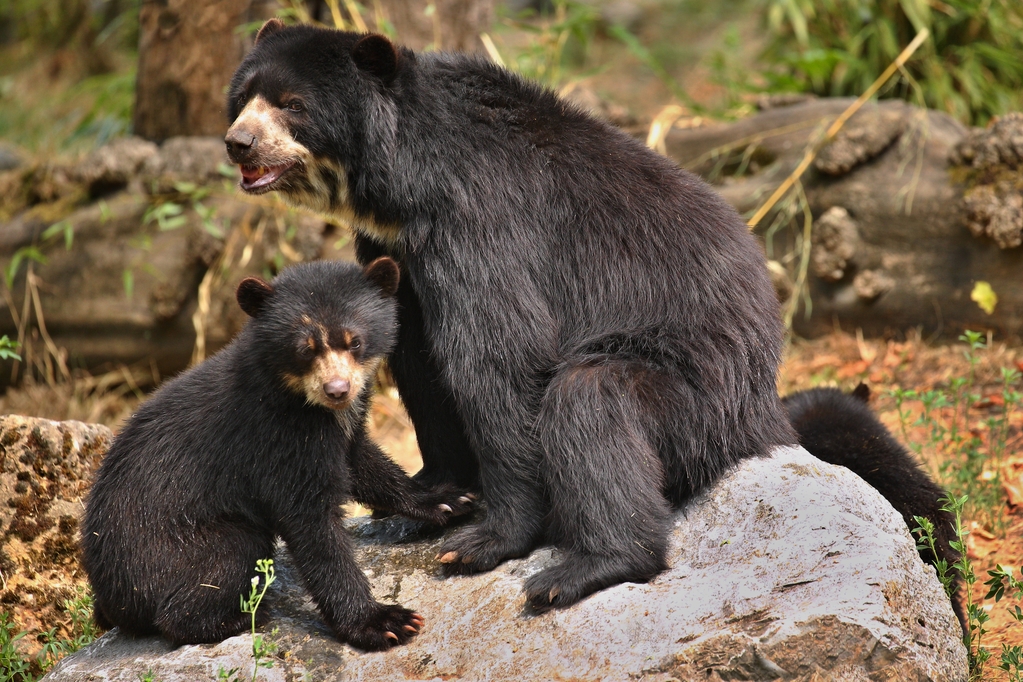What is so special about the Andean bear?
The Andean bear, also known as the spectacled bear, is the only bear species found in South America.
Here are some reasons why it is considered special.
5 facts about the Andean spectacled bear:
- Unique Appearance: The Andean bear has a distinct appearance, with its black or brown fur, and white or beige patches around its eyes, resembling spectacles. This unique marking gives the bear its common name.
- Omnivorous Diet: The Andean bear is an omnivore, meaning it eats both plants and animals. Its diet can include fruits, vegetables, insects, small mammals, and even carrion.
- Tree Climbing Abilities: Unlike other bear species, Andean bears are excellent climbers and spend a lot of time in trees, using their sharp claws to climb and maneuver in their arboreal habitat.
- Cultural Significance: Andean bears have cultural significance in many indigenous communities in South America. They are considered sacred and are featured in artwork and mythology.
- Threatened Status: Unfortunately, Andean bears are considered vulnerable and face many threats, including habitat loss, hunting, and climate change. Conservation efforts are underway to protect these unique bears and their habitats.
Why is the Andean bear called the spectacled bear?
The Andean bear is called the spectacled bear because of the distinctive white or beige fur patches around its eyes that give the appearance of wearing spectacles or glasses. These patches can vary in size and shape among individual bears, and sometimes extend down to the bear’s neck or chest.
The spectacled bear’s scientific name, Tremarctos ornatus, also references these markings, with «ornatus» meaning decorated or adorned.
The markings are not only a defining feature of this unique bear species but also serve as a way to recognize individual bears from one another.
Where is the Andean spectacled bear habitat?
The Andean bear is found in the Andean regions of South America, which includes Venezuela, Colombia, Ecuador, Peru, and Bolivia. These bears inhabit various ecosystems, including cloud forests, grasslands, and mountainous regions, and can be found at elevations ranging from sea level up to over 13,000 feet (4,000 meters).
Andean bears are known for their adaptability and can survive in fragmented habitats, including agricultural areas and forest fragments. However, their habitat is under threat due to human activities such as deforestation, habitat fragmentation, and hunting, which puts their survival at risk.
Conservation efforts are underway to protect the remaining Andean bear populations and their habitats.

Where can you find and see Andean spectacled bears in their natural habitat?
There are a few places where it may be possible to see Andean spectacled bears, located in Peru, Ecuador, and Colombia.
In Peru, you can find and see them in the Chaparrí Ecological Reserve.
The Chaparrí Ecological Reserve is located in the Lambayeque region of northern Peru and is known for its unique dry forest ecosystem. The reserve is home to various plant and animal species, including several endemic and endangered species. One of them is the Andean spectacled bear, and the Chaparrí reserve is home to a healthy population of these bears.
How to get to the Chaparrí Ecological Reserve?
The Chaparrí Ecological Reserve is located in the Lambayeque region of northern Peru, about 70 kilometers (43 miles) northeast of the city of Chiclayo. Here are some ways to get to the reserve:
- By car: The most convenient way to get to the Chaparrí reserve is by car. You can rent a car or hire a taxi in Chiclayo to take you to the reserve. The trip takes about 2-3 hours, depending on traffic and road conditions.
- By bus: It’s also possible to get to the reserve by bus. Buses from Chiclayo to the town of Chongoyape, which is near the reserve, run regularly. From Chongoyape, you can hire a taxi or take a moto-taxi to the reserve.
- By tourism agency: Many tour operators in Chiclayo offer guided tours to the Chaparrí reserve, which include transportation, meals, and guided hikes in reserve. This is a good option if you don’t want to drive yourself or if you want to learn more about the ecology and wildlife of the reserve.
It’s important to note that the roads leading to the Chaparrí reserve can be rough and difficult to navigate, especially during the rainy season (December to March). Visitors should also be prepared for hot and dry weather and should bring plenty of water, sunscreen, and insect repellent.
If you want to visit the Chaparrí reserve and be able to see the Andean bear in a safe environment, you can contact us and make your reservation for the date of your trip at Chaparrí Expeditions.